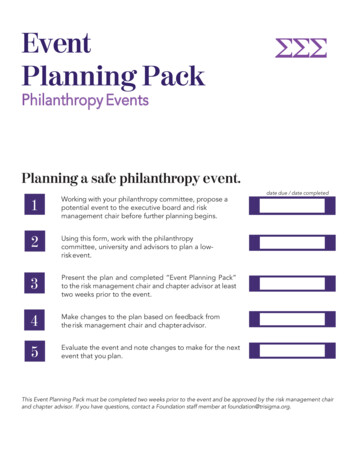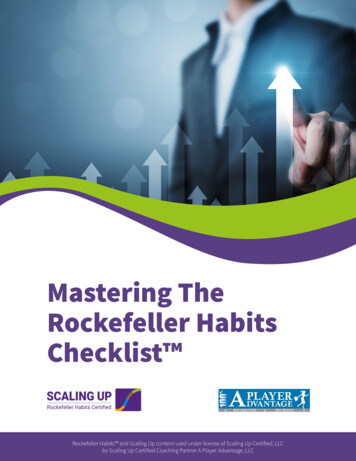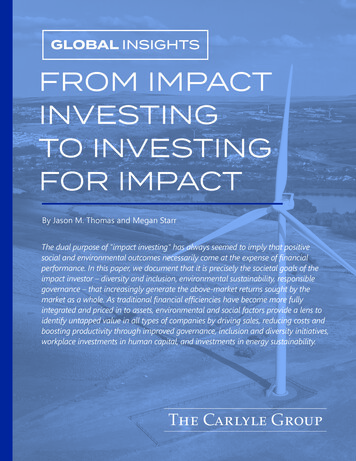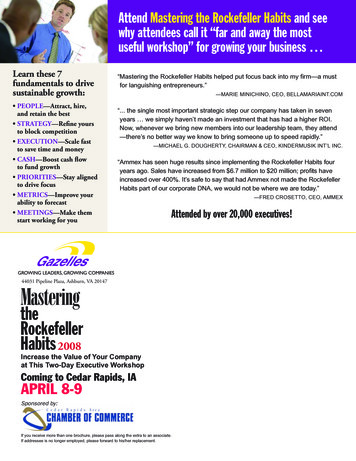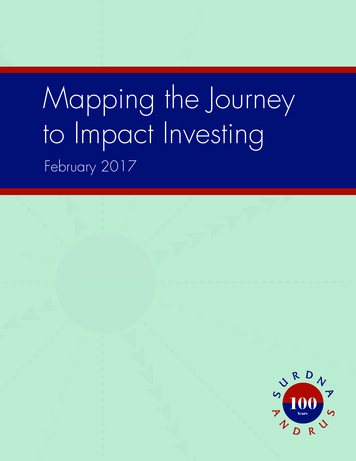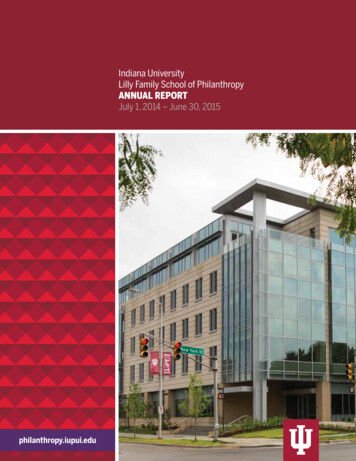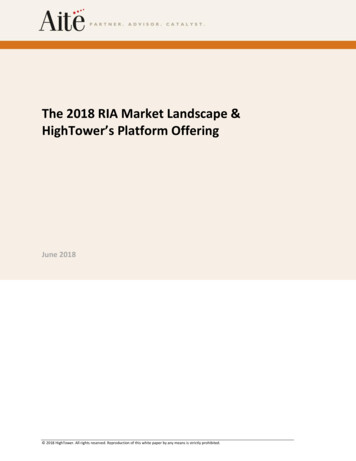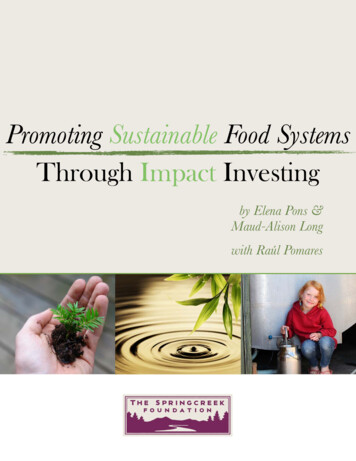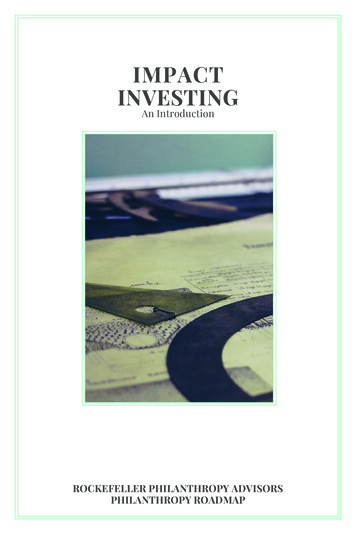
Transcription
IMPACTINVESTINGAn IntroductionROCKEFELLER PHILANTHROPY ADVISORSPHILANTHROPY ROADMAP
IMPACTINVESTINGAn IntroductionThis guide is part of Rockefeller Philanthropy Advisors’ PhilanthropyRoadmap series, and acts as an introduction to impact investing. Tobegin developing and implementing your impact investing strategy,we encourage you to also read our accompanying guide“Impact Investing: Strategy and Action.”ROCKEFELLER PHILANTHROPY ADVISORSPHILANTHROPY ROADMAP
What isImpact Investing?For many years, philanthropy and investing have been thoughtof as separate disciplines—one championing social change, theother financial gain. The idea that the two approaches could beintegrated in the same deals—in essence, delivering a financialreturn while doing good—struck most philanthropists and investorsas far-fetched.Not anymore.Impact investing, which seeks to generate social and/or environmentalbenefits while delivering a financial return, is expanding as a promisingtool for both investors and philanthropists. Some estimates value thecurrent impact investing market at nearly 9 trillion in the U.S. alone.1As the problems societies face become more entrenched and complex,it’s clear that government and philanthropy can’t solve them ontheir own. A look at the amounts of capital bears this out: in the U.S.,philanthropy is approximately 390 billion,2 government spending is 3.9trillion,3 and capital markets (all debt and equity investments) encompass 65 trillion.4 On a global scale, total investments are estimated at 300trillion.5 Thus, a 1% shift in global capital markets towards impactinvesting—or investments that work toward social good—could coverthe estimated outstanding 2.5 trillion annual funding gap to achieve theUnited Nations’ Sustainable Development Goals (SDGs).6 As this exampleshows, harnessing capital markets can have a huge societal benefit.2Impact Investments, DefinedImpact investments are defined as investments made into companies,organizations, and funds with the intention to generate social orenvironmental impact alongside a financial return.7While this definition leaves room for a broad set of investments, twokey elements should be present: intentionality and measurement. Theinvestor’s intention should include some element of both social impactand financial return. And while there is more consensus on metrics forfinancial return on investment (ROI), an impact investor should also aimto measure the social impact. In essence, all investments make an impacton society; some positive, some negative. Impact investors intentionallypursue investments that lead to measured positive social impact (for thepurposes of this guide, we include environmental impact in the broaderheader of social impact).There are two sides of any impact investing deal: the impact investor andthe impact investee. The goal is for both sides to benefit.IMPACT INVESTORIMPACT INVESTEEInvestments made withthe intention to generatemeasurable social impactalongside a financial returnA mission-driven organization(for-profit, nonprofit, or hybrid)with a market-based strategyImpact investing appeals to many potential investors because it balancescommerce and compassion. It also offers a broad range of options, asshown in the following diagram.3
Some strategies emphasize financial return while still seeking to benefitsociety. Other approaches put social impact first, accepting returns thatvary from below-market rate to a simple repayment of principal.between partners. These pioneering deals—which could includeinfusing capital into startup social enterprises, for example, orinvesting in pay-for-success contracts—often require expertadvice, especially for newcomers.IntentionFinance OnlyFinance FirstImpact FirstImpact OnlyPlease note: This guide assumes basic knowledge of philanthropy and ropyESG screenadded to anexistinginvestmentThematicEquity PRI inmarket-ratea hybridinvestment in a (e.g., benefitfor-profitcorporation)approaches, as well as financial tools and investment principles. For a review ofrelevant terms, please refer to the Glossary.Low-interestloan toa nonprofitExamplesFinding one’s place along the spectrum is a key consideration for anyimpact investor. At the far right, one motivated primarily by socialimpact might make a low interest loan or recoverable grant to a charity.At the other end, a financially driven approach might lead to an equityinvestment in a public company based on its integration of corporatesocial responsibility (CSR).Impact investments can be as straightforward as banking witha community-based financial institution that helps to expandeconomic opportunities for low-income stakeholders, orsupporting entrepreneurs in the developing world through a microfinance fund. Some of these types of investment, for example, solarpower, have been around for decades.Impact investments can also be incredibly complex, sometimescreating new financial vehicles or new types of arrangements45
Why Does ImpactInvesting Matter?Regardless of where one lands on the spectrum, impact investingprovides a tool for achieving social good with a wider array of assets thantraditional philanthropy. Private foundations in the U.S., for example, canachieve social good with not only their 5% required annual payout, butalso with the 95% endowment corpus that remains invested. To put thisin perspective, U.S. foundations make annual grants totaling 60 billion,while holding assets totaling 865 billion.8How does impact investing helpfurther impact goals?that all the world’s governments and many businesses and nonprofitscommitted themselves to beginning in 2016. The 2017 GIIN AnnualImpact Investor Survey found that 60% of investors reported actively (orsoon to be) tracking the financial performance of their investments withrespect to the SDGs.9How does impact investing helpfurther financial goals?1.Strong environmental, social, and governance (ESG) practicesembraced by many social good projects may lead to financialoutperformance.2.Merging investment and impact efforts can streamline strategyand help achieve returns (as well as impact) with larger pools ofmoney.3.Investors can bring market-based approaches to bear onthe social causes they care about while avoiding makinginvestments that are in opposition to their values.1. It’s a powerful tool for leveraging philanthropic dollars.Investment returns can be reused over and over again tocompound the impact.How can philanthropy helpadvance impact investing?2. It allows donors greater freedom and flexibility to test innovativeways to achieve a financial return as they seek impact.3. Donors use it to breathe new life into or complement theirphilanthropic strategy. Many report great satisfaction afterincorporating impact investing in a redesign of their approach tosocial change.When applied to specific social causes, impact investing also has thepotential to bring more capital and fresh approaches to targeted issueareas. For example, efforts are growing to coordinate impact investingwith the 17 Sustainable Development Goals (SDGs), 15-year global goals61.Philanthropy can pave the way for promising investments thatdon’t yet attract pure investment capital due to higher risk, anunproven track record, or an uncertain return timeline. In thiscase, philanthropy can provide risk capital, early capital, orpatient capital. One example is a loan guarantee allowing a socialenterprise to access credit at a favorable rate.2.For over a century, philanthropy has honed one of most7
challenging aspects of impact investing: impact measurement.Philanthropy can coordinate with impact investors toappropriately evaluate impact, which can then be measuredalong with the desired financial return.3.Philanthropy can help develop, scale and professionalize theimpact investing field through education, training, research andinfrastructure building.Two organizations that highlight the power of philanthropy’s roleare the Rockefeller Foundation and the Case Foundation. TheRockefeller Foundation helped shape this space in the mid2000s, by assembling a group of philanthropists, investors andentrepreneurs that coined the term “impact investing” and byincubating the Global Impact Investing Network (GIIN), the leadingnetwork of practitioners. More recently, the Case Foundationhas worked to build the field by creating a primer guide, narrativeanalytics on how the field is perceived, and a network map usingtransaction data to highlight investment activity and trends.8For over a century,philanthropy hashoned one of the mostchallenging aspectsof impact investing:impact measurement.9
Where is ImpactInvesting Going?As individuals and organizations seek new ways to tackle theproblems that matter to them, market-based approaches arebecoming better understood and more widely practiced.Here are some key indicators of impact investing’s growing influence:MARKET SIZE & GROWTHFrom the US SIF Foundation’s 2016 Report, assets under managementthat incorporate ESG considerations totaled 8.72 trillion—a 33%increase over 2014. These assets now account for more than one out ofevery five dollars under professional management in the United States.10FOUNDATION INTEGRATIONIn addition to the use of program-related investments (PRIs),foundations are beginning to invest endowment money for impactas well as financial growth. Many of the world’s largest foundationshave pledged a significant portion of their endowments towardsimpact investing, with the Ford Foundation’s 1 billion commitmentbeing the largest to date.GOING MAINSTREAMgrowth, such as the availability of qualified professionals, data onproducts and performance, and high-quality investment opportunities.INSTITUTIONAL INTERESTImpact investing has caught the attention of institutional investors,driven by client interest. BlackRock, Goldman Sachs, Bain Capital,and TPG are just a few that have taken significant steps to integrateimpact investing into their asset management offerings. Moreover,across the financial industry the number of SRI (socially responsibleinvesting) mutual fund and ETF offerings has grown rapidly overthe past few years. MSCI and Morningstar—leading providers ofindependent investment research—have also released ESG indicesand ratings to inform investment decisions.GOVERNMENT INVOLVEMENTPolicymakers and government entities have also shown increasedinterest. At the national level, the U.S. National Advisory Board onImpact Investing provides a framework for federal policy actionin support of impact investing. Internationally, the Global SocialImpact Investment Steering Group (GSG) was established in 2015as the successor to the Social Impact Investment Taskforce,established by the G8.As for regulation, in the U.S. for example, the Treasury and theDepartment of Labor in 2015 announced favorable rulings andguidance on applying social impact considerations towardsinvestment decisions. Many state and national governments arecurrently discussing such policy reforms.Surveys of high-net-worth households indicate that achieving socialimpact is important to over 90% of respondents,11 with interest set togrow as the millennial generation engages as philanthropists, creatingconditions for more experimentation and innovation. Furthermore,2017 GIIN Survey respondents saw progress in key indicators of industry1011
COMPETITIVE INVESTMENT RETURNSNumerous studies now point to the competitive nature of impactinvestment financial returns. For example, a report by CambridgeAssociates & GIIN shows that impact investment funds launched between1998 and 2004—those that are largely realized (converted to cash)—haveoutperformed funds in a comparable fund universe.12TAXONOMY & IMPACT MEASUREMENTAs impact investing gains traction among a wider range of investors,efforts to codify impact measurement have been amplified. Anumber of relevant frameworks now exist, an example of which isthe Impact Reporting and Investment Standards (IRIS)—an earlytaxonomy providing the foundation for impact measurement. Newaccounting standards are also in development by the SustainableAccounting Standards Board (SASB) to track social metrics inpublic companies.Pros and Cons ofImpact InvestingBenefitsDonors and investors say they are attracted to impactinvesting for a variety of reasons, including:RETURN ON INVESTMENTIn general, an impact investor can reinvest the same money in aseries of socially beneficial projects or organizations. Even a simplereturn of principal creates philanthropic leverage unattainablethrough traditional grantmaking.MORE ASSETS CAN BE ALIGNED WITHPHILANTHROPIC GOALSFoundations are required by law to disperse at least 5% of theirassets each year in order to achieve charitable goals. The remaining95% of foundation assets have traditionally been focused on seekingmarket returns. Impact investing allows more of that philanthropicmoney to be leveraged for social or environmental change.INVESTORS DON’T WORK AGAINST THEMSELVESWhen investments are in line with philanthropic values,donors don’t find themselves in the awkward situation ofholding public ownership in companies that conflict with—oreven actively undermine—their grantmaking strategy.1213
ChallengesDonors note that other aspects of impact investing canpose difficulties:INVESTMENTS CAN CARRY SIGNIFICANT RISKAs with traditional investments, impact investments come withvarious levels and types of risk, and it is arguably more ambitious fora company to aim for impact along two dimensions rather than one.For example, some social enterprises seeking impact investmentmay operate in underdeveloped markets, where a business ornonprofit faces the challenge of helping to create infrastructure aswell as provide a service.(as well as related legal issues), although growing, is only justemerging. Thus it can be difficult to build a team with the requisiteexpertise in both impact and financial return.DIFFICULTY OF MEASUREMENTWhile there have been great strides in standards for impactinvestment performance, coordinating an industry standardof impact measurement has proven difficult. Traditionally,investments and social impact occupied different spheresof life, approaches, and sources of capital, and socialimpact and assessment approaches are investor-specific.Accordingly, It can be quite challenging to break down thesebarriers, then decide how to integrate the two.LACK OF DEAL FLOW & EXIT STRATEGIESThe supply of investment opportunities offering scale, impact andfinancial return sometimes falls short of demand. As a result, impactinvestors can experience frustration finding deals that fit both theirinvestment criteria and their philanthropic orientation. Once aninvestment is made, it can be challenging to find an attractive exitstrategy. For example, the first IPO of a benefit corporation onlyoccurred in early 2017. In the international context, when investingin markets with government currency controls, it may be morecomplicated to get one’s cash back.LACK OF EXPERTISE & MARKET FRAGMENTATIONMany financial advisors lack expertise in the social aspects ofimpact investing. At the same time, many philanthropic advisorslack expertise in making financial investments. A new breed ofadvisors with experience in blending philanthropy and investment1415
CREATIVE SUPPORT FOR NEW COMMUNITIESWACHS FAMILY FUNDAs a philanthropic tool,impact investing canhelp even experienceddonors discover new ways tohelp the organizations andcauses they care about. For theWachs Family Fund, a donoradvised fund (DAF), it offered theflexibility to experiment—anda source of tailored supportfor a complex problem.to-own schemes that puthomeowners in a disparateposition of power relative todevelopers. Ownership of theland in these communities canbe complicated; harsh penaltieswithin many homeowners’agreements often resulted inland loss and instability. Whenthe owner of one coloniadefaulted on his loan and landownership transferred to thebank, the Texas Attorney Generalapproached CU and asked ifthey were willing to receive theproperty after bankruptcy andredevelop it. CU, enthusiasticabout delivering clear titles tothe people who lived there, saidyes. As the last of the affordableland in this region, coloniasprovide an important path tostabilizing communities. Familieswanted to stay for generations,but had trouble affording it,even with a steady income. CUbegan building model homesand locating financing for lowincome community members.Elizabeth Wachs, who createdthe DAF, had a longstandinggrant relationship withCommunities Unlimited (CU),an organization focused oncolonias, communities of lowincome individuals, often migrantworkers, who live at the fringesof incorporated areas in southTexas. Colonias are often the firstlanding ground for immigrants inthe state, particularly those fromMexico. They lack services orutilities, and their residents oftenoccupy improvised housing.CU began their work in thecolonias with access to cleanwater after a cholera outbreakin south Texas, which broughttheir attention to the rent-The Wachs Family Fund had beengiving unrestricted grants toCU before these developments,16which helped with home repair ortitle adjudication. Elizabeth alsobecame engaged with CU on apersonal level, gaining a deepunderstanding of their work.After plans for redeveloping thecolonias materialized, she metwith CU’s executive team andasked them what would reallyhelp push their work forward.Their answer: being able tocontrol tracts of land and buildaffordable housing, which wasclearly an expensive endeavor.CU brought up the idea of aloan. At first, the possibilitieswere unclear as Elizabeth wasn’tsure if she could make this kindof transaction through a DAF.But, during a dip in the financialmarkets and at a time when a 1 million grant wasn’t a viableoption, the idea made sense asa way to mitigate some of therisk of a grant and still makea crucial difference for CU’stime-sensitive work. With thehelp of her advisors, Elizabethwas able to structure a 1 millionprogram loan (distinct from aPRI, which is an option reservedfor foundations) that actedas CU’s land bank, structuredat 1% interest over sevenyears. CU used these fundsto leverage other institutionallenders and began to controlparcels of land, cycling throughthe process of building,attracting buyers, securingfinancing, and extractingthemselves. The Fund continuedto make concurrent grants,helping with organizationaldevelopment and construction.Of course, the loan still carrieduncertainty. Elizabeth’s trustin CU’s leadership, and thevalues of the organization,helped lay the groundworkfor a new way of workingtogether. She also leaned onthe expertise of her advisors,who had lending experience.In the end, the loan waseffective: it offered key bridgefinancing to help CU approachinstitutional lenders, andthe organization repaid thefund successfully. Within thecolonias, small constructionfirms grew to support the newbuilding efforts. And, as CUmoved forward, it became morecomfortable in market-basedapproaches to meeting theneeds of its communities.17
This example demonstratesseveral opportunities andchallenges of impact investing:The CU loan is an exampleof how a philanthropic lenscan make lending even morepowerful. In fact, Elizabeth feltthat her impact investmentwas a highlight of her givingexperience and even today,the Wachs family continues toview this kind of loan as one ofmany tools in their toolbox. At even a low 1% interestrate, the Wachs family’s ROIwas much greater than theycould have attained throughgrantmaking alone.How are ImpactInvestments Structured?Impact investments made by foundations and other mission-basedorganizations to further their philanthropic goals cover two distinctcategories:MISSION RELATED INVESMENT (MRI): MRIs are riskadjusted, market-rate investments made as part of a foundation’sendowment and have a positive social impact while contributing tothe foundation’s long-term financial stability and growth. The loan helped CU attractfinancing from establishedlenders. The donor’s history with CU, aswell as a deep understandingof programmatic systems andpriorities, fostered trust andreduced the risk that makinga loan to a small, relativelyinexperienced organizationmight otherwise have.PROGRAM RELATED INVESTMENT (PRI): PRIs are IRS-definedbelow-market rate investments made by private foundations designedto achieve specific program objectives. As opposed to MRIs, PRIs have alegal definition in the U.S. and count as a qualified distribution towardsa foundation’s 5% annual payout requirement. The Bill and MelindaGates Foundation, for example, uses PRIs to complement its traditionalgrantmaking and to scale social enterprises that serve the poor.13 Although this new structurewas a bit daunting and tookfar more effort than wouldhave been necessary for agrant, having an advisoryteam well-versed in bothphilanthropy and investingwas very beneficial.In addition to the distinction for foundations between MRIs and PRIs,the following categories will shape and be shaped by an investor’sspecific approach to impact investing.Investor StructureWhile the foundation structure has been the philanthropic vehicleof choice since 1969, the last 10 years have seen innovativestructures arise to match impact goals with available opportunities.Models utilizing LLCs, DAFs, private foundations and publiccharities, for example, have disrupted the traditional approach.For example, Laurene Powell Jobs was an early adopter of the1819
LLC as her primary vehicle in running the Emerson Collective.More recently, the Chan Zuckerberg Initiative has implementeda combination of LLC, DAF, private foundation, and 501(c)(4)structures—forgoing tax benefits to optimize flexibility andmaximize impact. For more information on how to structure yourphilanthropy, you may find RPA’s guide ”Operating for Impact” ahelpful resource.Investee StructureA new world is developing in which both for-profit companiesand nonprofit organizations can be values-driven and marketresponsive. More and more nonprofits are generating revenuethrough the sale of products or services, while for-profit companiesare integrating social good into their business models.To keep pace with these blended corporate aims, hybrid corporateforms have developed. For example, since the organization BLab began its work in 2006, 33 states have enacted legislationfor incorporation as a “benefit corporation,” in which a companyprioritizes public benefit over financial performance. In addition,over 2,000 organizations in over 50 countries have taken up a nonlegal designation of B Corporation that have been vetted to accountfor the company’s social purpose.Investment StructureThe structure of the transfer of money itself also has a range ofpossibilities. The investment structure can incorporate cash, private andpublic debt or equity, real assets, or other innovative instruments—suchas pay-for-success contracts. Of these options, the 2017 GIIN AnnualSurvey shows private debt as the most common investment structure.1420HARNESSING MARKETS TO SCALE CHANGEOMIDYAR NETWORKPierre Omidyar, founderof eBay, and his wifePam believe that thepower of markets can “createopportunity for people toimprove their lives.” That’s whythey started a “philanthropicinvestment firm,” the OmidyarNetwork (ON), in 2004.allows it to practice traditionalphilanthropy, make investmentsin worthy companies for areturn, and influence policiesthat affect the enablingconditions for its granteesand investees to thrive—for example, encouraginglaws allowing charitable taxdeductions, or engaging in policydiscussions about interest ratesfor microfinance institutions.These interrelated goalsreflect ON’s strategic intent:to create systemic change.Every year, they foregomillions of dollars in potentialtax deductions to be able tocombine grantmaking andinvestment outside the normalumbrella of a foundation.In 2013, the Omidyar Networkapplied the strategy when itinvested in MicroEnsure, whichprovides health, life, cropand other kinds of insuranceproducts to low-incomeclients in Asia, Africa and theCaribbean. Most of these clientsdidn’t have insurance before.Why?Through the experience ofbuilding eBay, they discoveredthe potential of unleashingmarket forces for good. Theybelieve that scaling innovativeorganizations can be the bestway to achieve impact—and thatscale can and should be attainedthrough multiple pathways. Thismeans that their social impactactivities operate through bothnonprofit and for-profit means.ON’s organizational structureMicroEnsure began as anonprofit wing of OpportunityInternational, and Omidyarsupported the effort withtraditional grants. Over time,as the enterprise matured, itbecame clear that there was21
sufficient scope to spin it out asa commercial entity—an exciting,if potentially complex, process.that will provide “millions ofconsumers and their families acritical safety net over the longterm.” The Omidyar Networkremains deeply engaged in theongoing work of the company,providing human capital inaddition to financial investment.To support that process, theOmidyar Network providedbridge funding—a lowinterest loan that offeredMicroEnsure flexibility andtime to put all the piecestogether to make the transitioninto a commercial venture.Omidyar’s involvement withMicroEnsure demonstrates thecontinuum of capital that canbe applied to nurture an idea,bring it to scale, bridge gaps, andtransform it into a sustainable,commercially funded venturethat has a positive social impact.That loan then converted toequity as the Omidyar Networkand the International FinanceCorporation (a part of the WorldBank Group) partnered to makea 5 million investment tospur MicroEnsure’s growth. Atthe same time, MicroEnsurelaunched a new joint venturewith giant mobile providerTelenor in order to offerMicroEnsure’s low-cost, mobilefriendly insurance products tomore than 149 million Telenorclients in Asia and EasternEurope. With MicroEnsure’s fourmillion customer base at thetime of the deal, the opportunityfor increased impact was clear.“It’s a small price topay to be able to usethe power of theprivate sector toimwprove people’slives on a verylarge scale.”Is Impact Investing aGood Fit for You?Whether impact investing is a strategy you should consider willdepend on your values and goals, and on how well you understandthe opportunities before you. Impact investing can be dauntingbecause it requires both financial acumen and philanthropic issueknowledge—a rare combination—not to mention unique humanresources and legal considerations.Yet, the field offers great potential.Virtually any philanthropic issue has an impact investmentopportunity associated with it, and virtually every asset class usedin a traditional investment portfolio has an impact equivalent. In anage when social entrepreneurs, technology and connectivity haveredefined the potential to improve people’s lives, impact investingseems an ideal vehicle for linking the power of markets with thepassion to do good.One key concept to remember: impact investing is one tool of many toachieve your goals. First, determine what success might look like, thenwork backwards to determine how you might integrate impact investinginto your overall portfolio.PIERRE OMIDYAR, ON THE DECISIONTO FORGO TAX DEDUCTIONSTO MAXIMIZE IMPACTMicroEnsure’s transition was a“welcome evolution,” accordingto colleagues at Omidyar, one2223
“The Ford Foundation’s approachhas unique value to add with 1B ofassets committed, while our [SurdnaFoundation’s] approach has particularinfluence with 100M committed the keyis to view impact investing as one of manytools we need all different approachesto realize the fullness of what impactinvesting has to offer.”SHUAIB A. SIDDIQUI, DIRECTOR OF IMPACT INVESTING,SURDNA FOUNDATIONTo consider the next steps in taking action towards impact investingstrategy and implementation, please refer to the accompanying guide,“Impact Investing: Strategy and Action,” which will explore how toprepare for, build, and refine your approach to impact investing.2425
ResourcesHere are additional resources for yourimpact investing journey.B LABbcorporation.netA nonprofit organization focused on using business for goodthrough its B Corporation certification, promoting new missionaligned corporate forms, and providing analytics for measuringwhat matters.CONFLUENCE PHILANTHROPYconfluencephilanthropy.orgA non-profit network of over 200 foundations that builds capacityand provides technical assistance to enhance the ability to alignthe management of assets with organizational mission to promoteenvironmental sustainability and social justice.GLOBAL IMPACT INVESTING NETWORKthegiin.org (Knowledge Center: thegiin.org/knowledge-center)A network of impact investing professionals advancing the impactinvesting industry and offering information and resources toinvestors, including a global directory of impact investing funds(ImpactBase), a set of metrics to measure and describe social,environmental and financial performance (IRIS), an annual survey ofimpact investing trends, and a rating system for impact investingfunds using B Lab methodology (GIIRS).IMPACTBASEimpactbase.orgA searchable online database of impact investing funds andproducts, helping connect investors with investment opportunities.26IMPACTASSETSimpactassets.orgA nonprofit financial services firm dedicated to advancing thefield of impact investing, publishing an annual database of 50experienced private debt and equity impact investmentfund managers.INVESTORS CIRCLEinvestorscircle.netAn early-stage impact investor network made up of individual angelinvestors, professional venture capitalists, foundation trustees andofficers and family office representatives.MISSION INVESTORS EXCHANGEmissioninvestors.orgNetwork of foundations and mission investing organizationsoffering workshops, webinars and a library of reports, guide
impact investing into their asset management offerings. Moreover, across the financial industry the number of SRI (socially responsible investing) mutual fund and ETF offerings has grown rapidly over the past few years. MSCI and Morningstar—leading providers of independent investment research—have also released ESG indices
